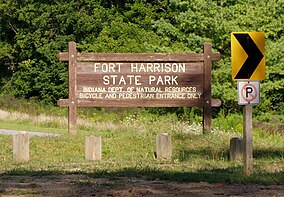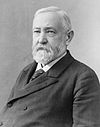
Otter Creek Outdoor Recreation Area is a 2,600 acre (11 km²) riverfront park in Meade County, Kentucky. The park is located near Muldraugh and Fort Knox, along State Highway 1638, near U.S. 31W. Although it is located outside Louisville, the park was long operated by the city of Louisville and, after the 2003 merger of the city and Jefferson County, Louisville Metro Government. Both entities attempted to give or sell the park to Meade County and the Commonwealth of Kentucky at various times over the years, most recently in 2004. The park closed in 2009 and reopened in 2011. It is now operated by the Kentucky Department of Fish and Wildlife Resources.

Fort Yargo State Park is a 1,816-acre (7.35 km2) U.S. state park located in Winder, Georgia, situated between Athens and Atlanta. The park is located 1 mile south of Winder and is accessible by Georgia State Route 81. There is a 260-acre (1.1 km2) lake with a public beach. Available activities at Fort Yargo include GeoCaching, hiking, mountain biking, disc golf, boating, lake swimming, fishing, picnicking, and miniature golf. The park also features a log fort built in 1792 by settlers, for protection against the Creek and Cherokee.
Potato Creek State Park is an Indiana state park located in north-central part of the U.S. state of Indiana about 12 miles (19 km) southwest of South Bend. Potato Creek is open year-round and supports various activities and facilities, including fishing, hiking, camping and mountain biking. Natural habitats include the 327-acre (1.3 km2) Worster Lake, old fields, mature woodlands, restored prairies, and diverse restored wetlands. Each offers different opportunities for plant and wildlife observation. The northeast corner has been designated "Swamp Rose Nature Preserve"; now about 1 square mile is either wetlands or in Worster Lake. Potato Creek receives about 570,000 visitors annually.

Oak Mountain State Park is a public recreation area located approximately 20 miles (32 km) south of Birmingham in the northeast quadrant of the city of Pelham, Alabama, United States. It is the state's largest state park at 9,940 acres (4,020 ha) and is home to the Alabama Wildlife Center, Oak Mountain Interpretive Center, and Oak Mountain BMX Track. Park activities include hiking, running, mountain biking, swimming, camping, fishing, horseback riding, and golf. The park is managed by the Alabama Department of Conservation and Natural Resources.

Brown County State Park is located in the United States in the center of the southern half of the state of Indiana. The park is by far the largest of 24 state parks in Indiana, and occupies 15,776 acres (63.84 km2)—making it one of the larger state parks in the United States. It is among Indiana's most visited state parks with about 1.2 million visitors annually. Although Bloomington, Indiana, is the closest city, the park is closer to the small town of Nashville in Brown County. Brown County is named for General Jacob Brown, who fought in the War of 1812 and became Commanding General of the United States Army.

Garfield Park is a 128-acre (52 ha) regional city park in Indianapolis, Indiana, United States. Established in the late 19th century, it is the oldest city park in Indianapolis and is on the National Register of Historic Places. The park is located at the confluence of Pleasant Run and Bean Creeks on the near Southside of Indianapolis. The 10,000-square-foot (930 m2) Conservatory and Sunken Gardens are located in the eastern portion of the park. The noted landscape architect George Edward Kessler designed the Sunken Gardens along with many of the other features of the park as part of his Park and Boulevard Plan for the city.

Seneca Creek State Park is a public recreation area encompassing more than 6,300 acres (2,500 ha) along 14 miles of Seneca Creek in its run to the Potomac River in Montgomery County, Maryland. The park features facilities for boating and fishing as well as trails for hiking, cycling, and horseback riding. It is managed by the Maryland Department of Natural Resources.

Three Rivers Park District is a special park district serving the suburban areas of the Twin Cities including suburban Hennepin, Carver, Dakota, Scott, and Ramsey counties. Three Rivers's mission is "To promote environmental stewardship through recreation and education in a natural resources-based park system." Three Rivers operates twenty parks and ten regional trails, with at least two more regional trails planned. Nearly seven million people visit Three Rivers facilities each year. It has over 27,000 acres (11,000 ha) of parks and trails.
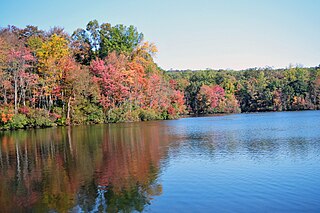
French Creek State Park is a 7,977-acre (3,228 ha) Pennsylvania state park in North Coventry and Warwick Townships in Chester County and Robeson and Union Townships in Berks County, Pennsylvania. It straddles northern Chester County and southern Berks County along French Creek. It is located in the Hopewell Big Woods. The park is the home of two lakes: Hopewell Lake, a 68-acre (28 ha) warm water lake, and Scotts Run Lake, a 22-acre (8.9 ha) cold water lake. The state record smallmouth bass was caught in Scotts Run Lake. There are extensive forests, and almost 40 miles (64 km) of hiking and equestrian trails. The park is also friendly to mountain bikers, having some renowned technical trails. Hopewell Furnace National Historic Site, which features a cold blast furnace restored to its 1830s appearance, is surrounded by the park. The Six Penny Day Use Area and Group Camp are listed on the National Register of Historic Places. French Creek State Park is located off of Pennsylvania Route 345 to the south of Birdsboro.
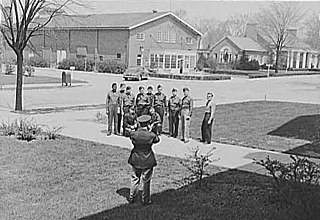
Fort Benjamin Harrison was a U.S. Army post located in suburban Lawrence Township, Marion County, Indiana, northeast of Indianapolis, between 1906 and 1991. It is named for the 23rd United States president, Benjamin Harrison.
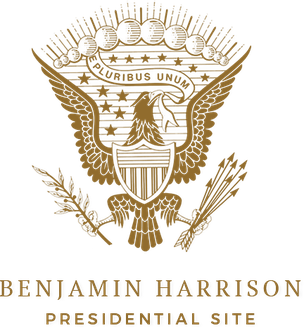
The Benjamin Harrison Presidential Site, previously known as the Benjamin Harrison Home, is the former home of the twenty-third president of the United States, Benjamin Harrison. It is in the Old Northside Historic District of Indianapolis, Indiana. Harrison's 16-room house was built from 1874 to 1875. It was from the front porch of the house that Harrison instituted his famous Front Porch Campaign in the 1888 United States presidential campaign, often speaking to crowds on the street. In 1896, Harrison renovated the house and added electricity. He died there in a second-story bedroom in 1901. Today it is owned by the Arthur Jordan Foundation and operated as a museum to the former president by the Benjamin Harrison Foundation.
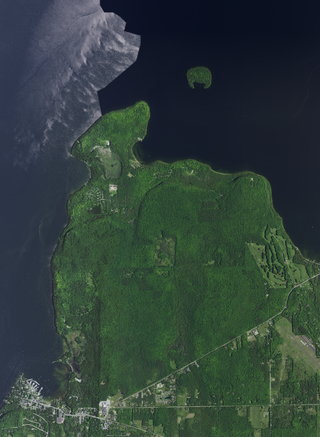
Peninsula State Park is a 3,776-acre (1,528 ha) Wisconsin state park with eight miles (13 km) of Green Bay shoreline in Door County. Peninsula is the third largest state park in Wisconsin and is visited by an estimated one million visitors annually.

Denton Hill State Park is a 700-acre (283 ha) Pennsylvania state park in Ulysses Township, Potter County, Pennsylvania, in the United States. The park is a downhill skiing resort. Denton Hill State Park is on U.S. Route 6 between Coudersport and Galeton. In 2000 the park became part of the Hills Creek State Park complex, an administrative grouping of eight state parks in Potter and Tioga counties.
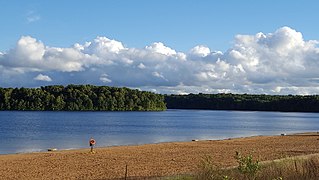
Fort Custer State Recreation Area is a 3,033-acre (12 km2) State Recreation Area located between Battle Creek and Kalamazoo, Michigan. The area features lakes, the Kalamazoo River, over 25 miles of multi-use trails, second growth oak barrens and dry-mesic southern (oak-hickory) forests.
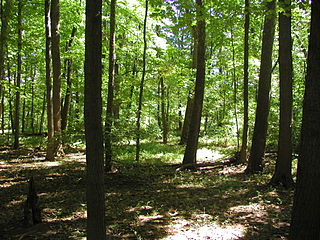
Evansburg State Park is a 3,349-acre (1,355 ha) Pennsylvania state park in Lower Providence, Lower Salford, Skippack, Towamencin, and Worcester Townships in Montgomery County, Pennsylvania in the United States. The park has a variety of habitats including forests, meadows, old fields, and farmland. The park offers a variety of recreational opportunities including picnicking, golf, ball fields, biking, hiking, hunting, horseback riding, and fishing. Evansburg State Park is near Collegeville and Norristown just off Pennsylvania Route 363.

Camp Morton was a military training ground and a Union prisoner-of-war camp in Indianapolis, Indiana, during the American Civil War. It was named for Indiana governor Oliver Morton. Prior to the war, the site served as the fairgrounds for the Indiana State Fair. During the war, Camp Morton was initially used as a military training ground. The first Union troops arrived at the camp in April 1861. After the fall of Fort Donelson and the Battle of Shiloh, the site was converted into a prisoner-of-war camp. The first Confederate prisoners arrived at Camp Morton on February 22, 1862; its last prisoners were paroled on June 12, 1865. At the conclusion of the war, the property resumed its role as the fairgrounds for the Indiana State Fair. In 1891 the property was sold and developed into a residential neighborhood known as Morton Place, a part of the Herron-Morton Place Historic District.
During the American Civil War, Indianapolis, the state capital of Indiana, was a major base of supplies for the Union. Governor Oliver P. Morton, a major supporter of President Abraham Lincoln, quickly made Indianapolis a gathering place to organize and train troops for the Union army. The city became a major railroad hub for troop transport to Confederate lands, and therefore had military importance. Twenty-four military camps were established in the vicinity of Indianapolis. Camp Morton, the initial mustering ground to organize and train the state's Union volunteers in 1861, was designated as a major prisoner-of-war camp for captured Confederate soldiers in 1862. In addition to military camps, a state-owned arsenal was established in the city in 1861, and a federal arsenal in 1862. A Soldiers' Home and a Ladies' Home were established in Indianapolis to house and feed Union soldiers and their families as they passed through the city. Indianapolis residents also supported the Union cause by providing soldiers with food, clothing, equipment, and supplies, despite rising prices and wartime hardships, such as food and clothing shortages. Local doctors aided the sick, some area women provided nursing care, and Indianapolis City Hospital tended to wounded soldiers. Indianapolis sent an estimated 4,000 men into military service; an estimated 700 died during the war. Indianapolis's Crown Hill National Cemetery was established as one of two national military cemeteries established in Indiana in 1866.

Military Park is the oldest public park in Indianapolis, Indiana, covering 14 acres (6 ha). It is located in western downtown Indianapolis. It was added to the National Register of Historic Places on October 28, 1969.

Fort Custer Training Center, often known simply as Fort Custer, is a federally owned and state-operated Michigan Army National Guard training facility, but is also used by other branches of the armed forces and armed forces from Illinois, Indiana, and Ohio. It is one of the most heavily used Midwest training facilities and is used mainly for company level small arms and maintenance training.
